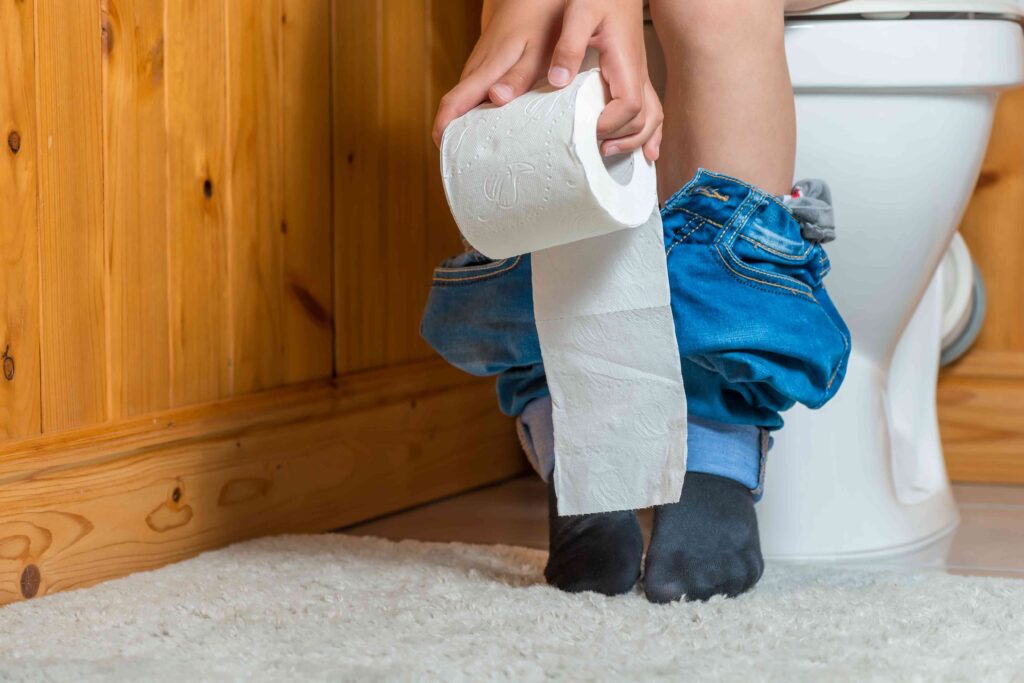:max_bytes(150000):strip_icc():format(jpeg)/health-GettyImages-1061915642-bedabf0d0dfb4ee5ac94091e7147151d.jpg)
Noticing red poop can be surprising, but it’s not always an emergency. Red poop sometimes happens when you eat certain foods. Other times, it could be a sign of gastrointestinal (GI) tract bleeding, which can occur due to digestive disorders, medications, and infections.
Upper GI tract bleeding is common, sending roughly 100,000 people in the United States to the hospital every year. If you’re noticing red poop accompanied by other unexplained symptoms like pain and weight loss, it’s important to see a healthcare provider to understand what’s going on.
Red poop describes a bowel movement that appears some shade of red, compared to the typical brown poop color. Red stool can look different for each person and vary depending on the underlying cause.
When you experience red poop due to something you ate, your stool may appear similar to the color of red dye. Red poop that happens as a result of lower gastrointestinal (GI) tract bleeding is usually bright red, while upper GI tract bleeding (like from your stomach) might appear more maroon-colored.
Red poop varies in shade, frequency, and amount. It’s possible to notice more intensely-colored red poop once in a while or slightly red poop several days in a row. Depending on the cause, red poop might also present with symptoms like stomach pain, painful bowel movements, itching around the anal area, and unexpected weight loss.
Red poop can occur due to a variety of factors—including foods, medications, and digestive disorders.
Diet
Your diet is one common reason why you may be noticing red poop. Certain foods with artificial dyes or natural colors can temporarily turn your poop a shade of red. This is usually a sign that the body hasn’t completely digested the pigments in the food coloring.
Some of the most common culprits include:
- Foods with Red Dye 40 food coloring (e.g., gelatin, popsicles, and red sports drinks)
- Tomato soup or juice
- Beets
- Cranberries
Even if a food product doesn’t appear noticeably red, it may still contain artificial dyes that affect poop color, so check the food label to be sure. If your diet is the cause of your red poop, you likely won’t have any other symptoms that would indicate a GI issue, such as stomach pain or fever.
Hemorrhoids
Hemorrhoids are swollen blood vessels that occur inside or outside of the anus. Because they can burst and bleed, you can develop red poop or notice blood on the toilet paper when you wipe. Hemorrhoids may be caused by long-term constipation or diarrhea, eating a low-fiber diet, or repeatedly straining during bowel movements.
If hemorrhoids are the reason for your red poop, you may notice other symptoms like itching and pain in the anal area. They’re not typically a cause for concern and are easily treatable with over-the-counter (OTC) or prescription medications.
Other Health Conditions
Experiencing brighter or darker red poop can be a sign of bleeding in the GI tract. Health conditions (such as digestive disorders) may trigger blood in your stool, known as rectal bleeding.
The most common conditions that can cause rectal bleeding include:
- Anal fissure: A small tear in the tissue lining of the anus can cause bleeding, leading to a red-colored bowel movement.
- Colon polyps: Abnormal tissue growths inside the colon can bleed, prompting bloody stool that may appear bright red or dark red, depending on where the bleed occurs.
- Colorectal cancer: Research suggests that cancer of the colon, anus, or rectum commonly causes bleeding that might result in noticeably red poop.
- Diverticular disease: In addition to stomach bloating or cramping, bloody poop can be another symptom of diverticular disease, which happens when small sacs in the wall of the colon become inflamed or infected.
- Inflammatory bowel disease (IBD): Both Crohn’s disease and ulcerative colitis fall under the IBD umbrella and cause inflammation in the GI tract—often leading to bleeding and red poop that may be diarrhea-like.
- Infection: Certain infections impacting the GI tract, including bacterial gastroenteritis and E. coli, may trigger red poop or red diarrhea.
- Rectal prolapse: Red, bloody poop may occur if the rectum starts sagging and coming out through the anus.
Medications
Several medications and supplements could also be prompting red-colored stools, including:
- Antibiotics: Some antibiotics used to treat bacterial infections, including Mycobutin (rifabutin) and Achromycin V (tetracycline), may cause red-tinted stools.
- Bismuth: Over-the-counter medications containing this stomach-soothing ingredient (e.g., Pepto-Bismol) tend to turn your poop to a dark red (or sometimes black) shade.
- Corticosteroids: This class of anti-inflammatory drugs has been linked to an increased risk for GI bleeding that might manifest as red stools.
- Iron supplements: Though it’s rare, supplementing with too much iron may lead to stomach damage and GI bleeding, resulting in bright red poop.
- Medications that contain red dyes: Medications like cherry-flavored syrups or laxatives can trigger dark reddish tints in your stool.
- Nonsteroidal anti-inflammatory drugs (NSAIDs): Over-the-counter pain relievers can increase the risk of developing stomach ulcers, which may lead to GI bleeding and red poop.
If you think medication may be causing your red poop, check with a healthcare provider before suddenly stopping or replacing a medication on your own.
Noticing an occasional change in your poop color isn’t necessarily a cause for alarm. Red poop that continues for a couple of days merits a call to a healthcare provider to receive a proper evaluation.
Seek medical attention right away if you notice red poop alongside symptoms such as:
- Fever
- Fatigue
- Dizziness
- Vomiting blood
- Blood in your bowel movement
- Unexplained weight loss
A healthcare provider will want to rule out dietary causes vs. GI tract bleeding. In addition to performing a physical exam, asking about your symptoms, and reviewing your medical history, your provider may order one or more of the following tests to determine if there is blood in your red poop:
- Stool tests to confirm the presence of blood in the stool and test for infection or inflammation
- Blood tests to check for signs of infection, cancer, or other health conditions
- Colonoscopy to view the inside of the lower GI tract, typically for colon polyps or colorectal cancer
- Endoscopy to examine the upper GI tract for any abnormalities
Your provider may also refer you to a gastroenterologist, a doctor specializing in gut health and digestive disorders.
Before a healthcare provider can treat red poop, they need to determine if GI bleeding is the cause of your symptoms. Medications are often the first line of treatment for red poop from conditions that cause GI bleeding (e.g., stomach ulcers, inflammation, or infection). Surgery may be required in serious cases where attempts to stop GI bleeding haven’t been successful.
If your red poop is due to diet, refrain from eating the food that triggered your red poop to return your poop color to normal. If medications are causing your red stools, your provider may recommend adjusting your dose and prescribing a different medication.
It’s not uncommon for poop colors to vary occasionally. Experts recommend a few tips for supporting healthy, regular bowel movements overall:
- Be mindful of eating foods that contain artificial or natural red dye
- Avoid straining during bowel movements by eating high-fiber foods, drinking plenty of water, and limiting time spent sitting on the toilet
- Take medications as prescribed and tell your provider about any side effects you experience
- Treat underlying digestive disorders that may be causing your symptoms
- Get screened for colorectal cancer, particularly if you have a family history of bowel cancer
Red poop can be caused by consuming certain foods or medications, or it can be a sign of gastrointestinal (GI) tract bleeding. GI bleeding may sound scary, but it’s not always an emergency. Treatable issues like hemorrhoids and stomach ulcers often lead to red-colored stool. More serious digestive disorders, including colon polyps and colorectal cancer, are also potential triggers.
See a healthcare provider if you’re noticing frequent red poop and aren’t sure of the cause. They can help you identify the cause and prescribe necessary treatment to help you feel better.













